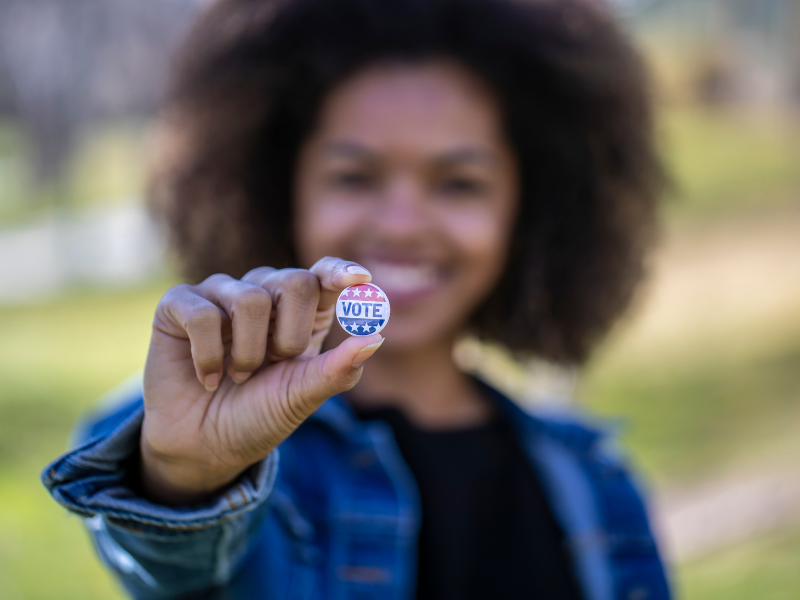How the Youth Vote Determined the Midterms (And Will Shape Future Elections)
Cameron Katz, ACE Intern
|November 22, 2022

Ahead of the 2022 Midterms, many political commentators claimed that a “red wave” would overtake the U.S. Senate and House of Representatives. Historically, it has proven difficult for the President’s party to maintain control of Congress during the midterms, as the political pendulum tends to swing in the other direction. This year, there were several indicators that Republicans were likely to retake the Senate with force. Issues like inflation typically push voters to the right. Plus, ongoing culture wars have only deepened the divides between Americans. But in the end, it came down to one group to determine the election: young people.
Voting organizations, like Action for the Climate Emergency (ACE) and When We All Vote, prioritize getting young people registered to vote. But getting out the youth vote is often a challenge for a litany of reasons, such as confusing information for young people living out of their home state (e.g. for college or an internship), lack of transportation, and general voter apathy.
Still, young people turned out the vote. According to the Center for Information and Research on Civic Learning and Engagement (CIRCLE) at Tufts University, 27% of young people aged 18-29 voted in the 2022 Midterms, many of them deciding key elections. This was the second highest youth voter turnout for the midterms in the past 30 years, just 4% behind participation in the 2018 elections.
The sustained youth vote is a great sign that young people are passionate about maintaining their civic engagement — and that they see voting as a main part of it. According to a study from the Philanthropy for Active Civic Engagement (PACE), 49.3% of 18-34 year olds named voting as the most important action to ensuring democracy works.
One of the key reasons why young people had such a monumental impact on the midterm elections is because this generation is far less politically divided. The same report from CIRCLE showed evidence that young people support Democrats by a significant margin: 62% voted Democrat and 35% voted Republican. This margin was even wider in key Senate and gubernatorial elections, and it increases even more for young people of color.
In fact, the youth vote had such an impact on this election that some commentators have suggested that the United States increase the voting age. Doing so would require repealing the 26th Amendment, which lowered the voting age to eighteen in 1971. The reason? Young men were being sent to war without being able to vote.
During World War II, the government lowered the military service age to 18, meaning that young men could be drafted to fight without being able to vote for another three years. A new voting rights movement was born. The movement came to a head in the 1970s with the Vietnam War, which was incredibly unpopular, especially among the men being drafted. On top of that, politicians on both sides of the aisle saw the youth voting bloc as a huge source of untapped potential. These young men and women were starting businesses, getting married, and participating in American politics in other ways. It just made sense for them to be able to vote. And so the 26th Amendment passed with huge bipartisan support: 94-0 in the Senate and 401-19 in the House.
The generational divide between Gen Z/Millennials and Baby Boomers is interesting, given that both generations have had to fight for their voice in American politics. Although the political divides between younger and older Americans are stark, surely we can all agree that everyone deserves a seat at the table.
Young people could continue their influence on elections with the upcoming Senate runoff race in Georgia between Raphael Warnock and Herschel Walker. According to the CIRCLE report, young people overwhelmingly supported Warnock, 63% to 36% in the fall midterms. In comparison, voters aged 30-44 supported Warnock 56% to 41% and voters 45 and above mostly supported Walker. Georgia also has an above average number of youth voters (13%) compared to the rest of the United States. Yet again, it could be young people who determine this key race.
Want to read more from ACE? Check out our Blog.
Join our Youth Action Network
More Blog Posts

Unnatural, Not Unprecedented
For two weeks, residents of Southern California endured a waking nightmare. Parents raced against time – hurrying down the driveway …
Read MoreCrafting a Vision for the Future: My Experience at LCOY USA 2024
Dry and sunny Tempe, Arizona where temperatures have been over 100 F for 113 consecutive days, delegates gathered to attend …
Read More
7 Ways to Weatherproof Your Home on the Cheap (+1 Not-So-Cheap)
As colder weather sets in, understanding how to weatherproof your home is key to maintaining warmth and reducing energy costs. …
Read More